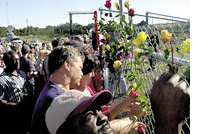
Image: the Birmingham Post-Herald
Last September 23, as many Americans watched the World Trade Center memorial service at Yankee Stadium, 32 men — lured by Sunday double time — descended into the deepest coal mine in North America. Owned by Jim Walter Resources, Blue Creek Number 5 lies under Brookwood, Alabama (population 1,483). The miners rode ‘the cage” 210 stories down into gloom, heat, and the methane gas emitted by seams of coal.
Officials believe that as Gaston Adams Jr. and three other miners worked to shore up a shaft ceiling, falling rock hit a battery charger, sparking a methane explosion. Pinned, Adams gave his headlamp to his buddies and waited in the dark for rescue. As the mine was evacuated, 12 men, most in their 50s, tried to save Adams instead. Forty-five minutes later, a second, more powerful blast killed them all and set off a fire that raged for three days, until the company flooded the shaft. It was the worst coal-mining disaster in nearly 20 years.
Normally this would have been national news. But last fall there was no more room in the American psyche for tragedy or heroism. A year later, however, families and survivors are demanding to be heard. In 10 different lawsuits, they allege that “wanton” and “willful” negligence on the part of Jim Walter Resources and its managers led, in the words of one suit, to “conditions that were extremely dangerous and hazardous, creating great risks of death and serious injury.” Just prior to the blast, miners say, faulty ventilation systems led to methane levels so high that some workers, including Adams, refused to run machinery, preferring instead to shore up ceilings. Company spokesman Kyle Parks says methane is inevitable in a deep coal mine, but that “there were no ventilation problems that we were aware of.”
Federal records indicate otherwise. According to Mine Safety and Health Administration (MSHA) inspection reports, the Number 5 mine had a history of excessive safety hazards and 31 outstanding violations at the time of the accident. Just six days before the disaster, MSHA inspectors wrote that methane concentrations “in excess of 5 percent” posed an “imminent danger” and that the company’s “approved ventilation plan was not being complied with.” Inspectors also found excessive coal dust, which can fuel explosions, and unsupported roof areas.
It was a recipe for disaster, but the agency didn’t follow through. “This is not an MSHA inspector problem,” says Joseph Main, director of the United Mine Workers of America’s health and safety department. “This is an MSHA management problem.” In a March letter to David Lauriski, the agency’s new boss, Main complained that coal-mine deaths are on the rise, and MSHA “has backed off enforcement of health and safety laws.” In part, Main blames the cozy relationship between industry and MSHA. For example, an MSHA official that the Number 5 inspectors reported to — Terry Langley — used to be a Jim Walter manager, the type of situation that disgusts Brookwood survivor Robert Tarvin. “Going to dinner and playing golf and all this kind of junk,” he spits. The revolving door extends to Washington, where the Bush administration has stacked the agency with industry officials, including Lauriski. “If you know the history of this industry,” Main says, “you can see why miners would be concerned when coal company bosses take over the administration of mine safety and health laws.” But MSHA spokeswoman Kathy Snyder replies, “The numbers of coal-mine inspections and citations issued have remained stable in recent years.”
Workers’ compensation laws protect companies and their supervisors from lawsuits related to on-the-job accidents. So until MSHA and the union complete their investigations, the lawsuits are in limbo. “None of us wants to spend the time and resources chasing one rabbit, when we should be chasing another,” says lawyer Jeffrey Rickard. Perhaps the best hope for change at the mine lies with Mike Boyd, brother of victim Clarence Boyd. Now vice president of the union local, Boyd continues to work at the Number 5 mine so as to ensure that there’s a whistleblower on site. “As long as Jim Walter is around, I’m going to be in those coal mines,” Boyd says. “It will be one of two things. [Either] the public will realize when they fire me, the reason why they fire me. Or [the company] is going to start to do things right.”












